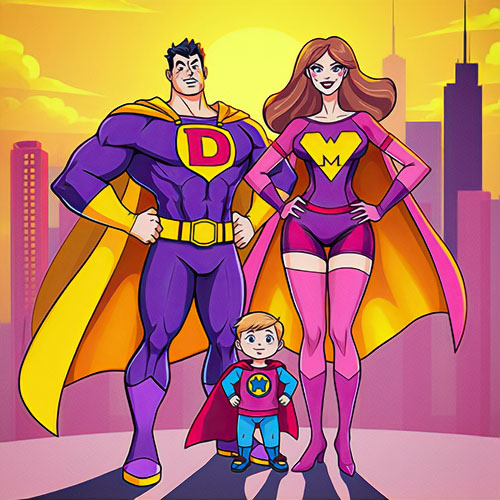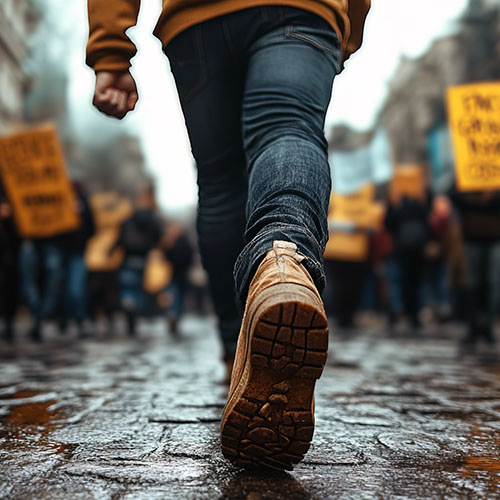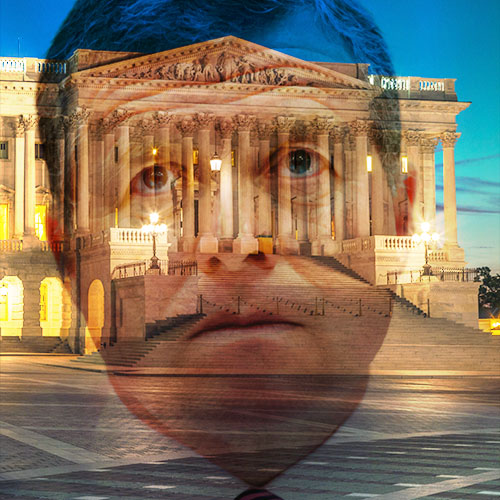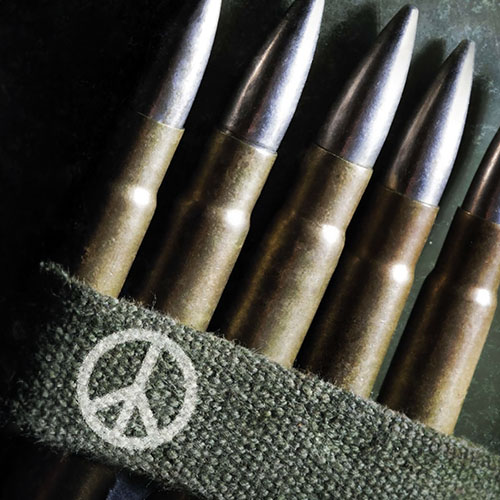Inside Angola Prison’s controversial inmate rodeo.
Joe Keene — a 34-year-old Louisiana prisoner — wears a protective Kevlar vest in case he takes a bull’s hoof or horn to the torso, or hits the ground hard. Fastening the buttons to a black-and-white striped shirt, his convict-cowboy uniform, he prays to the soul of his late mother, who passed away nine years ago. A big part of her had already died when he was convicted of murder in 2004, and his prayer is more a plea for mercy from a woman who, trying to keep her son out of jail, testified in court that the bloody khaki shorts police found at the family’s Baton Rouge apartment were hers, and that the blood was hers, too.
A bull in chute number six is huffing and heaving. Arms draped over a rail, Keene takes a look at the animal’s explosive mass of roiling muscle. A white inmate, tall, rangy, and sinewy, Keene tells himself he’s a real rodeo rider, not an animal in a zoo. Some of the spectators in this jammed arena might be here to see him get violently tossed, or worse, but Keene ignores that. When the loudspeaker announces his name and number, and he’s riding that bull, he briefly feels free. For a short, thrilling moment, his jail cell is forgotten. And if he rides well, he earns applause and accolades, and makes a good memory for those endless hours of confinement.
There’s a whole heap of pageantry before Keene gets to ride, though. “It’s going to get wild and western, you can tell!” says a ring announcer on horseback, speaking into his wireless mic. Behind him, caged and corralled animals snort and buck in agreement.
A prisoner with a heaven-sent voice sings “God Bless America.”Later, the audience stands and applauds in honor of the U.S. military as America’s wars are recited. The clapping surges at the mention of Operation Desert Storm and the Iraq War. There are people throughout this arena who fought in these wars, or are the children of those who did.
After “The Star-Spangled Banner” is sung, a cowgirl in tight jeans and a snug denim jacket, waving a big American flag, does two laps of the ring on her horse. She’s trailed by a decorated wagon bearing a banner inscribed “Friends of New Orleans Police Department.” Riding up front in the wagon, a “king” and his “queen” wave to thousands of spectators, people who have traveled here from Georgia, Alabama, Texas, and Mississippi. As the announcer hails the various states, people roar. Louisiana gets the biggest cheer, though, because that’s where we are.
We’re on the 18,000-acre grounds of the Louisiana State Penitentiary, the country’s largest maximum-security prison, 130 miles northwest of New Orleans. It’s known as Angola Prison, a name nodding to the land’s antebellum history as Angola Plantations, worked by slaves, many born in Africa’s Angola. It’s also called “The Farm” and “Alcatraz of the South,” though that second moniker is dying out. On one weekend every April, and four October weekends, this purpose-built arena hosts the Angola Prison Rodeo.
Ten thousand spectators cheer ten rodeo events, including Bust Out, Joe Keene’s favorite. The name is a winking reference to a prison break. Bust Out features six convict-cowboys on six angry bulls, with the animals sprung from their chutes simultaneously. The last man still atop his bull wins. Since most of the prisoners are untrained, they generally bite the dust as soon as the chute-gate opens. But Keene is a 19-time Bust Out champion. In fact, he won this event the day before. However, on this April Sunday, he doesn’t have his best stuff. He rides well for a few seconds, then hits the ground.
“I just didn’t feel right — in the only place I ever feel right,” he tells me later.
As a rodeo clown distracts his bull, Keene is dragged clear by fellow convicts. Then “Summer of ’69” starts playing, and spectators whoop along to Bryan Adams recalling the best days of his life. I hear a clown mutter the phrase “bad dude,” and I’m not sure if he’s talking about Keene, his bull, or Bryan Adams.
Moments later, the ring announcer declares, “And now, Pinball!”
In this event, convicts wearing Kevlar and face-guarded helmets stand inside hula hoops set on the dirt. A bull is released into the arena and rampages around. The inmate brave enough, or lucky enough, to hold his ground longest wins. This year, Pinball is sponsored by Daniel Miremont, president of a Baton Rouge sewer system company.
Joe Keene was convicted of murdering a Baton Rouge man, who was bludgeoned and strangled with Keene’s belt, in the victim’s apartment. He had an accomplice, a local drug-dealer.
Keene, 20 at the time, changed his story in the three statements he gave to police, but it appears he had been doing some minor plumbing work for the victim, and was in need of money to pay for drugs. He claimed his accomplice had threatened to shoot him unless he carried out the attack.
In email exchanges we have after the rodeo weekend, Keene focuses on the fact that his accomplice was able to plead to a lesser charge. He says it’s not right that “someone can hold a gun to your head and make you kill someone, and they walk away with the less part of time.” Neither prosecutors nor the jury found Keene’s account of the killing credible, however.
Keene tells me he’d never been in trouble before the murder, that he turned himself in to the police, and that I’m the first person he’s told this to. Loneliness is a theme in what he shares, and he is full of regret: that his parents sought to cover up his crime, and that he’s the end of the line for his father’s genes. When he reflects on his incarceration, Keene says, “I am…just waiting to die, which is crazy … you know.”
Being white, he is in the minority here — 80 percent of the inmates are black — but as a man serving life without parole, he’s also in a majority. Life without parole is the only sentence, besides the death penalty, that Louisiana gives for murder.
According to a Sentencing Project report, Louisiana has more people serving life without parole than Texas, Arkansas, Mississippi, Alabama, and Tennessee combined. This in a state that has had America’s highest incarceration rate for years. Its number of prisoners has grown 30 times faster than its population since the late seventies. Some hold up Louisiana — with its strict sentencing and pronounced law-and-order ethos — as an emblem of what’s good about America’s justice system. But for others, the state represents what’s horribly wrong with it.
Angola is often referred to as a “company town.” That company being the prison. But for over two decades, it would have been more accurate to call it a city-state governed by an absolute monarch. Longtime warden Burl Cain, who stated that his top priority was “moral rehabilitation,” introduced a Baptist seminary, prizefighting, and a culture of corporate kickbacks and side deals that led to his stepping down in 2016 amid corruption inquiries.
The island of Manhattan could fit inside the prison’s sprawling property, which is given over to farmland where gun towers and razor wire don’t predominate. The prison houses 6,300 prisoners and employs 1,800 staffers, from corrections officers to maintenance workers.
The past isn’t a foreign country at Angola Prison. To be reminded of this area’s bitter plantation history, you just have to gaze out over the landscape. Seated on horseback, mostly white guards patrol the fields of wheat, corn, soybeans, sorghum, and cotton that mostly black inmates harvest under a relentless sun for as little as four cents an hour.
Many of the prison staff live with their families on-site, within the B-Line, a small town, essentially, with its own parks, swimming pool, tennis court, fishing lake, and nine-hole Prison View Golf Course, which is open to the law-abiding public. To play the prison links as a non-staffer, you just have to give 48 hours’ notice before turning up with your clubs.
“It’s a great place to grow up,” says a teenage girl serving food at one of the rodeo’s various concession stands. “My dad’s a warden. I wanna be one, too.”
More than 70,000 people visit the Angola Prison grounds each year, viewing it as a Louisiana attraction. It’s not just the rodeo and golf course, with its tee markers in the shape of handcuffs, that draws them. The prison’s place on the dark tourism trail is secure thanks to its museum, which houses “Gruesome Gertie,” an electric chair built by inmates in which 87 of their peers were executed, including Elmo Patrick Sonnier, subject of Dead Man Walking, the book and movie. In 1991, the chair was retired in favor of lethal injection.
Angola’s biggest draw, though, is the rodeo.
Some of those seated in the 30-year-old arena are there to see murderers, armed robbers, and rapists get tossed and stomped by broncos and bulls — as though justice has found another way to be meted out. Others, mostly sorority girls in short shorts and abbreviated tops, appear to be shopping for husbands. And then there are the prisoners’ families, for whom this is an opportunity to see their captive fathers, brothers, and sons appear in a special public setting, with a chance to shine. The arena atmosphere is heady, sometimes hysterical, and has something of the Roman Colosseum, an Old West medicine show, and a slapstick comedy routine about it.
Five hours before the rodeo starts in earnest, the grounds beside the arena are taken over by an arts and crafts fair, where inmates do a keen trade in items they’ve created inside the prison: paintings, carvings, jewelry boxes, furniture, leather goods, wooden duck calls. Keene himself, who draws and paints, has been exhibiting at the fair for six years, he tells me.
“I have a lot of people that come back to the rodeo to buy stuff from me year after year,” he says. Some of them, he adds, just want something “they can say came from a killer.”
The food stands sell Louisiana staples like catfish po’ boys, and red beans and rice. There’s a petting zoo whose animals bring forth excited squeals from children. Some of the prisoners selling art are inside individual steel-mesh cages, tarped for shade, set in a few rows. Others, designated “trustees” by the prison (a category dependent on the convict’s crime and behavior in lockup) can walk freely, mingling with customers. Some convicts sit quietly in patches of shade and cuddle their grandkids. Others try out their rusty charms on women, the ice-cream sundaes in their hands doing most of the melting. The impression is one of wholesomeness under mild duress — a warm smile with a few missing teeth.
If a patron, after some bartering, wants to purchase an item from a caged prisoner, the man passes a slip of paper through the mesh, which is then carried to a cashier kiosk.
No one’s taking photos, since cameras and cell phones are not permitted on the grounds.
Prison guards mill around, of course, though a lot of them are also positioned at the entrance to the rodeo and fairgrounds, or are selling drinks at the food stands.
Calvin Stewart, one of the organizers of last year’s Angola work stoppage (protesting the prison farm and its forced labor, which he likens to a slave system), tells me to keep an eye out for Keene. I ask where he is, but I’m met with shrugs and guesses. (I’ll later learn he’d been inside the arena, helping prep the animals.) As I search, one of the caged men, a small white guy with a mustache, gives me a stare so cold my blood freezes. I don’t know what crime he committed, but I’ve never witnessed a look projecting that kind of darkness.
I meet a trustee prisoner-artist with dark brown hair and a goatee, a couple of decades older than Keene. Referring to the men in cages, mostly rapists and pedophiles, he says to me, “Someone should have said, they’re the ones not allowed anywhere near women and children. I can tell you that watching movies with them isn’t a lot of fun.”
During an autumn rodeo weekend in 2017, a convicted killer and a 13-year-old girl were seen emerging from a restroom together. Her family claimed a sexual violation took place. It became a national story — an alleged rape taking place during the rodeo. The convict, Laderrick Davis, serving a life sentence, was transferred to another prison, in part for his own safety. Then on November 10, the parish sheriff and chief of Louisiana’s prison system said the evidence gathered, including the results of a rape kit administered to the girl, showed no sexual contact had taken place. They also said the girl denied any contact.
The statements prompted one family member to tell New Orleans news station WGNO, “I feel like it was a cover-up. I feel like they are trying to sweep it under the rug.”
IN 2004, the year he represented Joe Keene, attorney D. Bert Garraway was attacked in court by another one of his clients, who put him in a headlock and slashed at his face and neck with a razor.
“I’ve contended all along that this guy is nuts,” a bloodied Garraway said. “And to be honest, this pretty much confirms it. What kind of rational person would attack his own lawyer?”
His client might well have been crazy, and a criminal, but there isn’t much love for defense lawyers around these parts, either.
As Angola is to the prison-industrial complex, so Louisiana is to shoddy legal defense. Reading about Keene’s crime and trial, I discovered a classic case of American-style injustice, a story that Keene, poor and semiliterate, with an eighth-grade education, had no hope of articulating on his own.
The jury found him guilty of both conspiracy to commit second-degree murder and second-degree murder, for which he was sentenced to hard labor for 30 years and life imprisonment, respectively. But an appeal against the conviction filed by a second public defender raised serious questions about Garraway’s handling of the case.
Keene claims that he had asked to plead guilty to manslaughter, which could have resulted in a shorter sentence, but Garraway had not allowed it.
“I wish I had the money to pay for a lawyer like the other guy,” he says by email.
A Louisiana defense lawyer who reviewed the case for me shared this opinion: “Only an idiot would have gone to trial without considering other options.” Speaking on the condition of anonymity, this lawyer said the case was mishandled in such a way as to make one think that the original defense attorney was “drunk, incompetent, or receiving kickbacks.”
The late D. Bert Garraway was a regular court-appointed attorney for the indigent accused, who had a rap sheet of his own. Convicted in 1988 of attempting to extort undercover federal agents on behalf of a client whose landfill site had been used as a chemical waste dump, he was disbarred for three months and sentenced to 300 hours of community service, which he completed as an attorney in the public defender’s office. Upon fulfilling this requirement, Garraway continued working as a defense attorney.
Opposite him in the Keene trial was Baton Rouge district attorney Doug Moreau. A diehard, God-fearing Republican, a former Miami Dolphins tight end, and a longtime broadcaster for LSU football games, Moreau put more people on death row than anyone else in Louisiana during his 18-year tenure as DA. He sees his old job in simple terms: “A person would be on death row because of something he did. He’s the one who started the process.”
The Sixth Amendment to the Constitution states that “in all criminal prosecutions, the accused shall enjoy the right…to have the assistance of counsel for his defense.” Two-and-a-quarter centuries later, millions of Americans lack proper legal representation.
In 2017, a report for the National Association of Criminal Justice Lawyers (titled “State of Crisis: Chronic Neglect and Underfunding for Louisiana’s Public Defense System”) asserted this about representation for people without means accused of crimes in Keene’s state: “The gravity of the situation there will require a concerted, sustained national effort to alleviate it. The widespread injustice faced by poor people in Louisiana’s courts, a disproportionate number of them people of color, demands the attention of everyone concerned about human dignity and fundamental rights.”
Statewide, public defense offices have blamed funding shortfalls on a drop in revenue from traffic violations. The claim is understandable. In Louisiana, these offices are primarily financed by traffic tickets and court fines, and traffic tickets have fallen 35 percent in ten years.
The dearth of funds means fewer lawyers and more cases per lawyer. Increased caseloads mean slower processing times, and increased backlogs of criminal cases mean more pretrial clients being held in jail, at a cost that is — at around $55 a day — greater than what would be required to adequately fund a defense.
And if that wasn’t bad enough, lawyers often have to double as their own support staff, doing duty as social workers and in-house investigators that Louisiana is also shamefully short of.
“I love it. I love it,” says Bubba Dunn of Angola Prison’s controversial, bleacher-packing spectacle.
Dunn — a former professional rodeo rider — serves as the stock contractor for the spring and autumn event. “It’s an old-time rodeo. Reminds me of how it used to be. Man versus beast.
That’s why people come here. Nobody wants to see anyone get killed, but they damn sure don’t want to miss a good wreck.
And the riders, they go for it because if they make money, they’ll have money for the canteen and they’ll get to buy their own clothes — not just wear prison-issue.”
The rodeo, which has been running since 1964, brings in around $450K during its April weekend. It is a source of pride for anyone connected with it. Angola officials see it as a tool of rehabilitation and are happy to cite reduced prison-violence numbers as proof of its efficacy. The rodeo helps pay for a raft of educational programs, re-entry training in such certified trades as auto repair or air-conditioner installation, and recreational supplies.
Inmates look forward to the event and associated Hobbycraft Fair, as it’s called. The rodeo and marketplace bring prisoners that brief taste of freedom. And they can make real money. They get to keep 85 percent of any Hobbycraft profits, with the rest going to the Inmate Welfare Fund, and state and local taxes. Cash prizes up to $500 are awarded to winners of the rodeo events. And then there’s the prestige that goes with winning the custom belt buckle if a rider is crowned the rodeo’s “All-Around Cowboy.”
On the other hand, there are the injuries, and the fact that spectators assemble in the thousands to watch incarcerated amateur participants, the majority serving life sentences, get thrown off bulls and broncos, as weekend entertainment. Convict-cowboys regularly break bones, or get lacerated by a bull’s horns. One rider in the 1970s, shaken by an enraged bull after a fall, spent the rest of his prison life as a quadriplegic.
There’s also the way the rodeo has a way of fortifying racial and socioeconomic stereotypes. African-American riders, riders from disadvantaged backgrounds, appear as, yes, human pinballs in a public arena to provide viewing enjoyment for a paying audience — a crowd whose racial mix roughly reverses that of the prison. The audience is predominantly white.
Some label the rodeo barbaric. Others argue that it has time-tested value — proven benefits — both for the prison population and for the way the prison operates as a whole.
Angola administrators vigorously defend their event in the face of criticism, which comes from observers both within Louisiana and nationally. One of those observers is Ashley Nellis of the Sentencing Project, a justice reform advocacy group. Says Nellis: “Prisoners benefit from being able to earn a little money. That’s a wonderful thing, but it’s not really a skill. [The rodeo] makes them feel connected to the community, but at the same time it reinforces our tendency to assume the violent nature of prisoners.”
Incarceration is said to serve four purposes: deterrence, incapacitation, retribution, and rehabilitation. Redemption is a different matter. Whatever a prisoner’s good works — his long hours of farm toil and artistic output — there’s little hope of redemption for him in Angola Prison without Christ. The federally funded Baptist seminary program, which was started by Burl Cain in 1995,
offers four-year college degrees in ministry, including instruction in Greek and Hebrew, as well as preaching. The students are usually lifers, and the assumption is that they will help other prisoners work through the issues that led them to commit crimes.
Cain is quoted by Texas state senator John Whitmire, a Democrat who has run the senate’s criminal justice committee for years, as saying: “With a moral attitude, even if an inmate will not be set free in this world, he looks forward to being free in the next.” Whitmire was impressed by the Angola program, and pushed the Texas Department of Criminal Justice to create its own seminary. There are now similar prison seminary programs in Mississippi, Georgia, New Mexico, Michigan, and West Virginia.
Legend has it that when Harry Whittington of the Texas Board of Corrections — the man who years later was shot by then-Vice President Dick Cheney while hunting quail — voted to abolish the state’s prison rodeo at Huntsville, a Lone Star flag behind him fell to the ground.
Earlier this year, Representative Ernest Bailes introduced a bill to reinstate the Huntsville rodeo, where Johnny Cash performed his first prison concert in 1956. This rodeo, which had taken place every Sunday in October for 55 years, ended in 1986 in part because its stadium was past the point of affordable repair. Making the case for a revival, Representative Bailes said, “Profits from the rodeo ticket sales alone would help fund education, recreation, and medical programs for inmates across Texas, as it did for so many years before.”
If we can judge a society by its prisons, the fact that officials in both Texas and neighboring Oklahoma want their prison rodeos to make a comeback tells us a lot.
Prison system budget issues late last century led to the demise of all but Angola’s rodeo, with insufficient funds available for infrastructure improvement and to pay staff to run the events. Meanwhile, in multiple prison systems, funding can now be found for religious training and the promotion of a narrow band of cultural values. And a couple states are weighing a return to an event where, like at Angola, prisoners would sing for their bland supper, and provide a spectacle, complete with chances for blood, concussions, and broken bones, to the paying public.
On that April Sunday at the prison rodeo, Pinball — an event with a $250 top prize — takes a turn for the ugly when a pair of prisoners get smashed by the bull and can barely move. They are helped out of the ring without fanfare, however, because Convict Poker is up next, and that’s always a crowd favorite.
In Convict Poker, four helmeted inmates sit at a small table as if playing cards, only to be rudely interrupted by a raging bull, which invariably sends the entire setup skyward. On this occasion, one inmate is catapulted into the air and lands in a worryingly crumpled heap. The dirt ring fills with several comrades trying to distract the bull in case it decides to add a trampling to the man’s woes.
Arguably, the main event of the festivities is Guts & Glory. It’s the biggest deal for the participating inmates anyway, because of the substantial prize money. A red poker chip is tied to the head of Angola’s angriest Brahma bull, which is then released into the arena. Prisoners compete to grab the chip and avoid getting battered or gored by the 2,000-pound beast in the process. Whoever retrieves the chip, if anyone, wins $500 in cash. Six weeks after that April installment of Guts & Glory, and the other rodeo events, I receive an email from Joe Keene.
Referring to his Bust Out ride, he writes, “I fell wrong and broke my collarbone and messed up my shoulder. I can still feel the bones moving where they shouldn’t be. They are talking about having to put a plate inside of me.”
In spite of his tumble, Keene scored well, notching a 78.5 on a hard ride, though it wasn’t enough to win. He tried to get back in the ring, to compete in another event, only to be told by medical personnel that he was too injured to continue.
Losing his crown as Bust Out champion hurts him more than any physical injury could, though these days, pain of one sort or another is simply a constant. “I am dead but alive,” Keene says, speaking of life without parole. “But that’s the hand that life has dealt me and so many others.”
The only thing that would mitigate his pain is forgiveness, but the forgiveness Keene craves is in the hands of very few people — his mother, his father, and his victim — and they are all dead. He would like to forgive himself, but he needs to be shown how. Until then, there’s the next rodeo, and the next, and the one after that.
(Note: The names of two Angola inmates have been changed in this article.)
Elle Hardy is a writer currently based in the American South. She hails from Australia and has reported from places like North Korea and Turkmenistan.



























